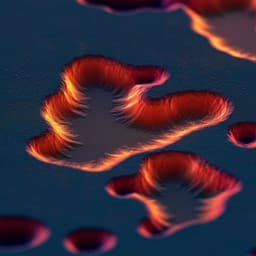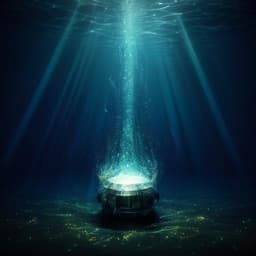
Earth Sciences
The cryptic seismic potential of the Pichilemu blind fault in Chile revealed by off-fault geomorphology
J. Jara-muñoz, D. Melnick, et al.
Discover the groundbreaking research on the previously unknown Pichilemu Fault in Chile, which caused a significant Mw 7.0 earthquake in 2010. This study, conducted by J. Jara-Muñoz and colleagues, estimates a fault-slip rate and recurrence time for normal-faulting earthquakes that could change our understanding of seismic hazards in the region.
~3 min • Beginner • English
Introduction
The study addresses how to assess the seismic potential of blind, previously unmapped faults in subduction forearcs, focusing on the Pichilemu Fault (PIF) in central Chile. Recent large earthquakes have ruptured along unidentified faults, highlighting gaps in fault mapping and hazard assessment. Blind faults do not rupture to the surface, making on-fault evidence scarce and complicating slip-rate and recurrence estimates. In subduction zones, upper-plate stress states change over the seismic cycle; megathrust events can promote extension and trigger crustal normal-fault earthquakes. Given the local hazard posed by such faults, the research aims to demonstrate that off-fault geomorphic markers—specifically uplifted marine terraces—together with geodesy can quantify long-term deformation and infer recurrence of upper-plate earthquakes on a blind fault.
Literature Review
The paper situates the PIF within a global context of cryptic faulting observed during events such as the 2016 Kaikōura and 2010 Darfield/2011 Christchurch earthquakes, and 2019 Ridgecrest sequence. Traditional active-fault mapping relies on surface ruptures and scarps, which are absent for blind faults; previous identifications have used geophysical imaging and indirect geomorphic signals. Upper-plate fault reactivation during and after megathrust earthquakes has been reported in Japan, Alaska, and Chile, with low slip-rate crustal faults exhibiting millennial recurrence. Prior studies in central Chile documented marine terrace sequences and forearc deformation patterns reflecting both long-wavelength (megathrust) and short-wavelength (crustal fault) components. Databases note multiple similar normal faults along the Maule segment. Empirical relationships link slip to magnitude, and Coulomb stress transfer explains triggered seismicity depending on megathrust slip distribution and depth.
Methodology
- Data and mapping: Used 1 m-resolution airborne LiDAR-derived DTM to map geomorphic features, drainage networks, lineaments, and marine terraces. Terrace mapping employed TerraceM-2. Generated red-relief maps, slope and local relief maps, and computed fluvial metrics with TopoToolbox-2.
- On-fault geomorphology analysis: Assessed catchment asymmetry via symmetry factor Ts, steepness index Ksn, knickpoint distribution (Topotoolbox knickpointfinder), chi-plots, ridge and swath profiles to search for surface scarps and their relation to lineaments (L1–L5). Evaluated lithologic controls using mapped metamorphic vs intrusive rocks.
- Off-fault geomorphology: Identified multiple marine terrace levels north and south of the PIF; measured shoreline-angle elevations within swath boxes and built longitudinal profiles. Correlated terrace levels to Marine Isotope Stages using luminescence ages and global sea-level curves to derive uplift rates and their uncertainties over ~620 ka.
- Geochronology: Dated terrace sediments using post-IR IRSL (elevated temperature) on K-feldspar. Samples: PICH-2 (115 m, 297 ± 29 ka, MIS 8), PICK− (51 m, 106 ± 9.3 ka, MIS 5d), LOBO-1 (320 m, 328 ± 33 ka, MIS 9), PICH-4 (38 m, 314 ± 30 ka, MIS 9). Evaluated dose rates from U, Th, K and moisture content; included a modern beach berm sample to assess signal resetting.
- Geodesy and coseismic deformation: Processed two Envisat InSAR scenes (2 days pre- and 7 days post-2010 PIF earthquakes) to obtain LOS displacements, with coherence filtering and unwrapping (Roi-Pac; branch-cut). Compared to GPS station PICH projected to LOS. Used clusters of 2010 aftershocks to define two PIF branches (F1 and F2) geometries (strike, dip, length; down-dip to ~26 km megathrust).
- Coseismic slip modelling: Performed forward elastic dislocation modelling (Okada in Matlab) iterating slip magnitudes and up-dip depths for F1 and F2 to fit LOS displacements; minimised NRMSE. Tested sensitivity and potential trade-offs between F1 and F2. Also conducted an inverse slip inversion using automated triangular fault discretization to retrieve heterogeneous slip, selecting regularisation via L-curve and jRi criteria.
- Long-term slip-rate modelling: Forward modelled vertical deformation fields from dislocations for F1 and F2 to replicate uplift-rate patterns inferred from shoreline angles (point-based) and from an interpolated uplift-rate surface. Varied up-dip depths and slip rates, evaluated fits with NRMSE, and obtained confidence intervals from NRMSE lower-tail distributions.
- Stress transfer analysis: Computed Coulomb failure stress (ΔCFS) on the PIF for various megathrust slip scenarios using published Maule slip models and synthetic distributions shifting the locus along-strike and in depth; also assessed interseismic locking field. Explored sensitivity to friction coefficient (0.4–0.75) and depth (5–25 km) averaging.
Key Findings
- No surface-breaching scarps attributable to the PIF were identified; deformation is distributed across a ~10 km-wide zone, consistent with blind faulting.
- Marine terrace analysis: North of the PIF, six wave-built terrace units (50–170 m) with post-IR IRSL ages 106 ± 9.3 ka (MIS 5d) and 297 ± 29 ka (MIS 8); south of the PIF, four wave-cut levels up to ~100 m, with sediments at 16–32 m yielding 328 ± 33 ka and 314 ± 30 ka (MIS 9). Uplift rates vary from 0.06–0.15 m/ka to 0.37–0.46 m/ka across the PIF, indicating long-term emergence over ~620 ka and a short-wavelength (~10 km) warping pattern.
- Coseismic slip (2010): Forward model best-fit indicates F1 slipped 1.1 m (90% CI 0.95–1.15 m) between ~26 km and ~4.6 km depth (CI 3.6–5.0 km); F2 slipped ~0.1 m (CI 0–0.4 m) to ~5.2 km up-dip (CI 2.2–5.4 km). Inverse model median slip on F1 is 1.2 m with a patch centered ~12.5 km depth extending up to ~6 km, consistent with blind rupture. Near-field residuals <0.05 m; larger far-field residuals likely due to post-seismic processes not modelled.
- Long-term slip rate: Best-fit forward model using interpolated uplift rates yields F1 slip rate 0.52 m/ka (CI 0.48–0.56 m/ka) and F2 slip rate 0.10 m/ka (CI 0.08–0.20 m/ka); alternative model using only shoreline-angle points gives similar values (F1 ~0.48 m/ka). Up-dip depths best-fit: F1 ~1.8 km (CI 1–2.6 km), F2 ~1.2 km (CI 0.8–3.4 km).
- Recurrence: Combining long-term slip rate (F1 ~0.52 m/ka) with 2010-like coseismic slip (~1.1–1.2 m) implies a recurrence time of ~2.12 ka (90% CI 1.85–2.28 ka) for Mw 6.7–6.8 events (seismic moment ~1.4 × 10^19 to 2.0 × 10^19 Nm). Mw 7 events would require ~1.65 m slip and ~3.2 ka recurrence.
- Stress triggering: ΔCFS at the PIF is positive (1.3–6 MPa) for the 2010 Maule rupture distribution; synthetic scenarios show that shallow slip on the northern Maule subsegment promotes PIF slip (ΔCFS ≳0.2–0.66 MPa), while southern or deeper (40–50 km) slip inhibits it (ΔCFS down to −2 MPa). Interseismic locking prior to 2010 imparts negative ΔCFS (~−1.44 MPa), inhibiting normal-fault slip, consistent with lack of prior extensional seismicity.
Discussion
The findings demonstrate that off-fault geomorphic markers—uplifted marine terraces—capture the short-wavelength vertical deformation signature of a blind, upper-plate normal fault, enabling quantification of long-term slip rates where on-fault evidence is absent. The close similarity between the modeled coseismic deformation (2010) and long-term terrace warping supports a consistent extensional kinematic framework for the PIF. The integration of geodesy and terrace-derived uplift rates indicates that large PIF earthquakes recur on millennial timescales (~2.1 ka), far less frequently than Mw > 8 megathrust events (~0.1–0.2 ka). Coulomb stress modeling links PIF activation to specific megathrust slip distributions—particularly shallow, northern-segment ruptures—explaining sporadic triggering and longer recurrence. The distributed aftershock zone and lack of scarps suggest rheologically heterogeneous upper crust that diffuses strain and hinders surface rupture. Regionally, similar normal faults in the Maule forearc may be sequentially triggered by successive megathrust events depending on rupture geometry, emphasizing the importance of considering blind upper-plate sources in coastal hazard assessments.
Conclusion
This study reveals the seismic potential of the blind Pichilemu Fault by leveraging off-fault geomorphic markers and geodetic modeling. It establishes a long-term slip rate of ~0.52 m/ka and a millennial recurrence (~2.12 ka) for Mw ~6.7–6.8 normal-faulting earthquakes, consistent with the 2010 sequence. The approach shows that distributed terrace warping can diagnose blind faulting where on-fault evidence is lacking. Coulomb stress analyses explain sporadic activation tied to megathrust slip location and depth. These results underscore that cryptic upper-plate faults at subduction margins can pose significant local hazards despite infrequent activity. Future work should expand high-resolution LiDAR mapping and off-fault marker analysis regionally, improve terrace chronologies, refine coupled megathrust–upper-plate stress models, and investigate rheological controls on surface rupture to enhance active-fault maps and hazard models.
Limitations
- Lack of direct surface ruptures limits on-fault validation; geomorphic evidence indicates distributed deformation, not localized scarps.
- InSAR coherence was relatively low; far-field residuals may reflect post-seismic deformation not included in coseismic models.
- Coseismic and long-term models assume planar fault geometries, homogeneous elastic half-space, and simplified slip distributions; up-dip depth is diffuse in aftershock data, introducing uncertainty.
- Terrace age control is limited to a few luminescence samples; correlations of some levels to MIS stages are tentative and based on global sea-level curves.
- Coulomb stress results depend on assumed friction coefficients, slip models, and locking distributions; scenario-dependent conclusions may vary with alternative inputs.
- Potential contributions from other local structures (e.g., N–S faults) remain uncertain and require further study.
Related Publications
Explore these studies to deepen your understanding of the subject.







